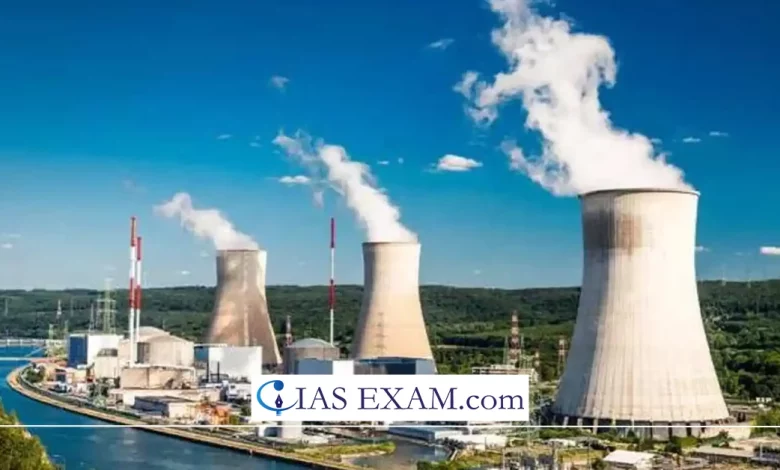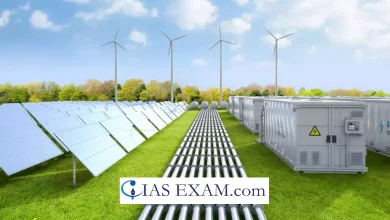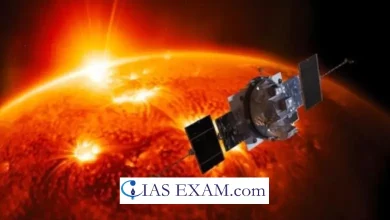
Context
As per a study by IIM Ahmedabad, investments in nuclear energy should be a priority to be a developed country by 2047 and to achieve net zero by 2070.
About Nuclear Energy
- Nuclear energy is the energy released during nuclear reactions, both through fission (splitting of atomic nuclei) or fusion (merging of atomic nuclei).
- In nuclear fission, heavy atomic nuclei, consisting of those of uranium or plutonium, are cut up into lighter nuclei, liberating a large amount of energy.
- This process is utilized in nuclear energy plants to generate electricity.
India’s Nuclear Programme
- Nuclear Energy is a non-carbon-emitting energy source that contributes less than 2% of India’s total electricity generation.
- NPCIL owns and operates India’s modern fleet of nuclear energy vegetation, with a capability of 7,500 MW, and has devoted investments for the rest 1,300 MW.
- India imports uranium fuel for nuclear plants from Russia, Kazakhstan, Uzbekistan, France and Canada under bilateral agreements.
Nuclear Energy for economic development
- Energy Security: The gas to electricity output ratio for nuclear energy is quite high. An exceptionally small amount of uranium can be used to fuel a 1000 Megawatts electric electric plant, thus providing enough electricity to power a city of about half a million people.
- Clean energy: The World Nuclear Association observed that the average emissions for nuclear energy are 29 tonnes of CO2 per gigawatt-hour (GWh) of energy produced.
- This compares favorably with solar (85 tonnes in step with GWh), wind (26 tonnes according to GWh) and fossil fuels like lignite (1,054 tonnes per GWh).
- Low Operating Costs: Nuclear energy produces very inexpensive electricity and is cheaper than gas, coal, or some other fossil fuel plant.
- Industrial Growth: Reliable and considerable energy supply will offer a solid source of electricity for Industries such as metallic, cement etc. So as to result in economic development.
Challenges
- Risky source of energy: The dangers of nuclear energy are ultimately uncontrollable.
- The Chernobyl catastrophe of 1986 and Fukushima disaster in Japan in 2011 have already shown the dangers of nuclear energy.
- Radioactive Waste Disposal: A nuclear energy plant creates 20 metric tons of nuclear fuel per year, and with that comes a lot of nuclear waste.
- Also the waste transmits radiation and high temperature, causing harm to living things in and around the plant.
- Uranium availability: Limited supplies of natural uranium, a critical fuel restricted by international embargo, is the biggest hurdle for nuclear power development.
- Financial Constraints: India would need close to ₹150-200 lakh crore among 2020-2070 to finance those transitions.
Suggestions as per the IIM document
- If nuclear power rises five-fold from today’s levels to 30 GW (gigawatt) by 2030 and 265 GW by 2050, the emissions in 2070 will fall to 0.55 billion tonnes of carbon dioxide (‘net zero’ scenario).
- It means nuclear energy contributing 4% of India’s overall energy by 2030 and sharply growing to 30% by 2050.
- In the equal scenario, the proportion of sun electricity falls from 42% in 2030 to 30% in 2050.
- Currently, solar energy accounts for 16% of India’s installed technology potential and coal 49%.
Conclusion
- Nuclear energy is a clean and environment-friendly supply of energy that’s available 24X7, and might provide the country long-term energy security in a sustainable way.
- The increase of the Indian nuclear energy application is vital to fulfill the twin goals of energy security and sustainable development.
Source: The Hindu
UPSC Mains Practice Question
Q.With growing energy needs should India keep on expanding its nuclear energy programme? Discuss the facts and fears associated with nuclear energy. (2018)





.png)



